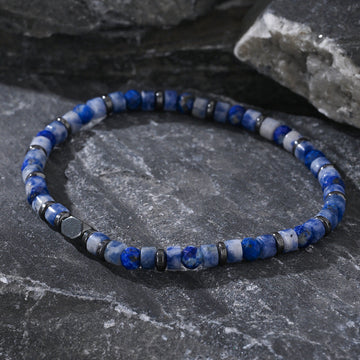Ethnic-Inspired Stone Bracelets: Celebrating Regional Cultural Identity Through Design
Ethnic stone bracelets are more than decorative accessories—they are cultural artifacts that embody the traditions, beliefs, and artistic heritage of diverse communities worldwide. These pieces often feature materials, motifs, and techniques unique to specific regions, serving as tangible expressions of identity and history. Below, we explore how different cultural influences shape the design of ethnic-inspired stone bracelets, from symbolic patterns to traditional craftsmanship.
Symbolic Motifs: Stories Told Through Stone and Metal
Many ethnic bracelets incorporate symbols that carry deep cultural or spiritual significance. In some African communities, for example, bracelets may feature carved motifs like the Adinkra symbols of Ghana, which represent concepts such as wisdom, strength, or unity. A stone bracelet with a central carnelian stone surrounded by engraved Adinkra patterns connects the wearer to ancestral heritage while celebrating communal values.
In Native American cultures, symbols like the thunderbird, arrow, or spiral are often integrated into jewelry design. These motifs may be carved into stones such as turquoise or jet, or etched into silver settings, reflecting a connection to nature and spirituality. For instance, a bracelet featuring a thunderbird design carved into a black onyx stone could symbolize protection and power, rooted in tribal mythology.
Asian cultures also contribute rich symbolic language to ethnic bracelets. The Chinese yin-yang symbol, representing balance and harmony, might appear alongside jade or agate stones, materials traditionally associated with longevity and prosperity. Similarly, Tibetan bracelets often incorporate the endless knot, a symbol of eternal interconnectedness, paired with turquoise or coral for spiritual significance.
Traditional Materials: Earthy Tones and Local Resources
The choice of materials in ethnic stone bracelets is deeply tied to geography and availability. In regions with abundant mineral deposits, stones native to the area become central to jewelry-making. For example, the Andes Mountains in South America are renowned for their vibrant stones like rhodochrosite, lapis lazuli, and pink opal, which are frequently used in Peruvian and Bolivian bracelets. These stones not only showcase the region’s natural beauty but also carry cultural meanings—rhodochrosite, for instance, is associated with love and compassion in Andean folklore.
In parts of Africa, bracelets may incorporate recycled materials like brass or bone alongside stones such as malachite or jasper. These combinations reflect resourcefulness and a connection to ancestral practices, where every element holds value. A bracelet made from recycled brass with inlaid malachite stones could symbolize resilience and continuity, echoing traditions passed down through generations.
Organic materials like wood, seeds, or shells are also common in ethnic designs, often paired with stones for texture and contrast. In Southeast Asia, bracelets might feature bamboo beads alongside carnelian or amethyst, blending natural elements with vibrant gemstones. This fusion highlights a harmonious relationship with the environment, a theme prevalent in many indigenous cultures.
Craftsmanship Techniques: Preserving Ancient Skills
The methods used to create ethnic stone bracelets are often as significant as the designs themselves. Many communities rely on time-honored techniques that have been refined over centuries, ensuring each piece is unique and culturally authentic. In Morocco, for example, artisans use a process called “filigree” to create delicate, lace-like metalwork around stones like amber or coral. This intricate method requires patience and precision, resulting in bracelets that are both lightweight and visually striking.
In Central Asia, the art of “kundan” setting—where stones are secured in metal without prongs or glue—is used to create elaborate bracelets. This technique, dating back to the Mughal era, involves heating gold foil to mold it around the stone, creating a seamless bond. A kundan-set bracelet with turquoise or garnet stones would showcase this labor-intensive craftsmanship while reflecting the region’s historical opulence.
Beadwork is another technique deeply rooted in ethnic jewelry traditions. Native American bracelets often feature hand-rolled beads made from glass, clay, or stone, strung together with sinew or leather. These beads may be arranged in patterns that tell stories or mark significant life events, such as rites of passage or tribal affiliations. A bracelet with turquoise beads and a central stone pendant could serve as a personal talisman, carrying both aesthetic and symbolic weight.
Regional Color Palettes: Reflecting Cultural Aesthetics
Color choices in ethnic stone bracelets are rarely arbitrary—they often align with cultural symbolism or natural surroundings. In Mexico, for example, bracelets may feature bright hues like red, turquoise, and yellow, mirroring the vibrant landscapes of Oaxaca or the festive traditions of Día de los Muertos. A bracelet with a red jasper stone and turquoise accents could evoke the energy of celebrations while honoring indigenous artistic traditions.
In contrast, Scandinavian and Nordic designs tend to favor muted tones like gray, white, and soft blue, reflecting the region’s icy landscapes and minimalist aesthetics. Bracelets from these areas might incorporate stones like moonstone or labradorite, paired with silver or reindeer leather, creating a serene, understated look that resonates with local sensibilities.
Middle Eastern bracelets often blend deep, rich colors such as emerald green, royal blue, or gold, inspired by the region’s history of trade and luxury. A bracelet with a lapis lazuli stone set in gold-tone metal could draw from Persian or Ottoman influences, exuding elegance and a sense of timeless sophistication.
Ethnic-inspired stone bracelets are a celebration of cultural diversity, weaving together symbols, materials, and techniques that reflect the unique identities of communities around the world. By honoring traditional craftsmanship and embracing regional aesthetics, these pieces serve as bridges between past and present, offering wearers a way to connect with heritage while expressing personal style. Whether adorned with symbolic motifs or crafted from locally sourced stones, each bracelet tells a story of belonging, creativity, and cultural pride.







